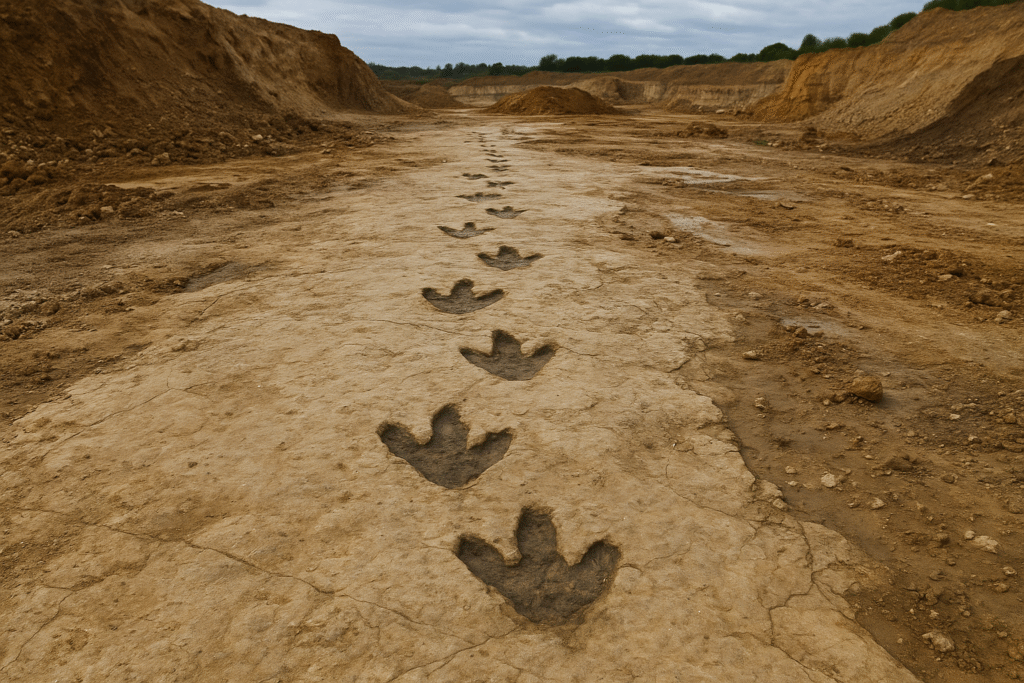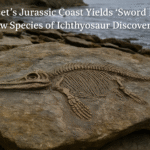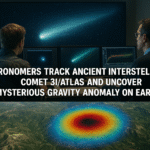By Harshit | 16 October 2025 | Oxfordshire, UK | 11:00 AM
A rare window into the Jurassic era has emerged in Oxfordshire, where palaeontologists are uncovering one of the longest and most detailed dinosaur trackways ever discovered. Hidden beneath tonnes of limestone at Dewars Farm Quarry, this prehistoric trail offers scientists unprecedented insight into the movement and behaviour of colossal creatures that roamed Earth 166 million years ago.
A Walk Through Prehistoric Times
This summer, a team of researchers descended on Dewars Farm Quarry to excavate the extraordinary site, where enormous footprints of long-necked, plant-eating sauropods extend across 220 metres of rock. Experts have dubbed the trail a “dinosaur superhighway,” believed to have been made by Cetiosaurus, a giant herbivore that could reach up to 18 metres in length.
“These footprints are insanely big,” said Emma Nicholls of Oxford University’s Museum of Natural History. “They belong to a sauropod that we know inhabited this region, giving us a direct link to the dinosaurs that walked here millions of years ago.”
The quarry has long been associated with dinosaur activity. Earlier discoveries in the 1990s revealed several trackways, and last year researchers uncovered 200 footprints across a different part of the site. This year’s excavation revealed even more tracks, forming a continuous trail stretching from one end of the quarry to the other.
Unearthing the Giant Footprints
Excavating such colossal prints requires both precision and strength. Controlled explosions remove layers of limestone, exposing the sunken impressions while preserving their delicate features. Palaeontologists then painstakingly use trowels, brushes, and buckets to uncover the footprints fully.
Aerial images show a series of hollows extending into the distance, each footprint roughly one metre across. Analysis reveals which direction the dinosaurs were moving, and in some cases, their back feet fit precisely into the impressions left by their front feet, providing insight into their stride and gait.
Smaller prints nearby belong to Megalosaurus, a two-legged carnivorous dinosaur up to nine metres long. These distinctive three-toed marks highlight the diversity of species inhabiting the Jurassic landscape and provide a striking contrast to the massive sauropod tracks.
Reconstructing Dinosaur Behaviour
Trackways capture dinosaurs in motion, offering unique insights impossible to glean from skeletons alone. “With a skeleton, you can estimate stride length, but a trackway shows the animal moving freely over hundreds of metres,” explained Peter Falkingham from Liverpool John Moores University.
Footprints allow scientists to explore questions about social behaviour: were these dinosaurs moving alone, in herds, or under threat? The trail can reveal if animals were walking leisurely, hunting, or being pursued.
Using the footprints, Falkingham has created 3D models of the sauropod’s movements. Analysis suggests the creature moved at around two metres per second — similar to a human walking briskly. Certain distinctive prints may provide even more detail on the dinosaur’s health, gait, and interactions with other creatures.
Scientific and Cultural Significance
The Dewars Farm Quarry trackway has importance beyond palaeontology. Sites like this have informed portrayals of dinosaurs in popular culture, including films like Jurassic Park. Real-life evidence of movement and behaviour allows animators and scientists to reconstruct prehistoric life accurately, enhancing both education and entertainment.
“This discovery is once-in-a-lifetime,” said University of Birmingham palaeontologist Kirsty Edgar. “It’s incredibly rare to uncover such a long, continuous trackway, and it will be an invaluable resource for studying locomotion, behaviour, and ecology of Jurassic dinosaurs.”
As excavations continue, researchers hope to uncover further clues about the prehistoric environment and the creatures that once roamed it. Each footprint adds a new piece to the puzzle, offering a tangible connection to a world that existed long before humans walked the Earth.
The Oxfordshire dinosaur superhighway not only enriches scientific knowledge but also inspires curiosity and imagination, reminding us of the grandeur and diversity of life that flourished millions of years ago.







